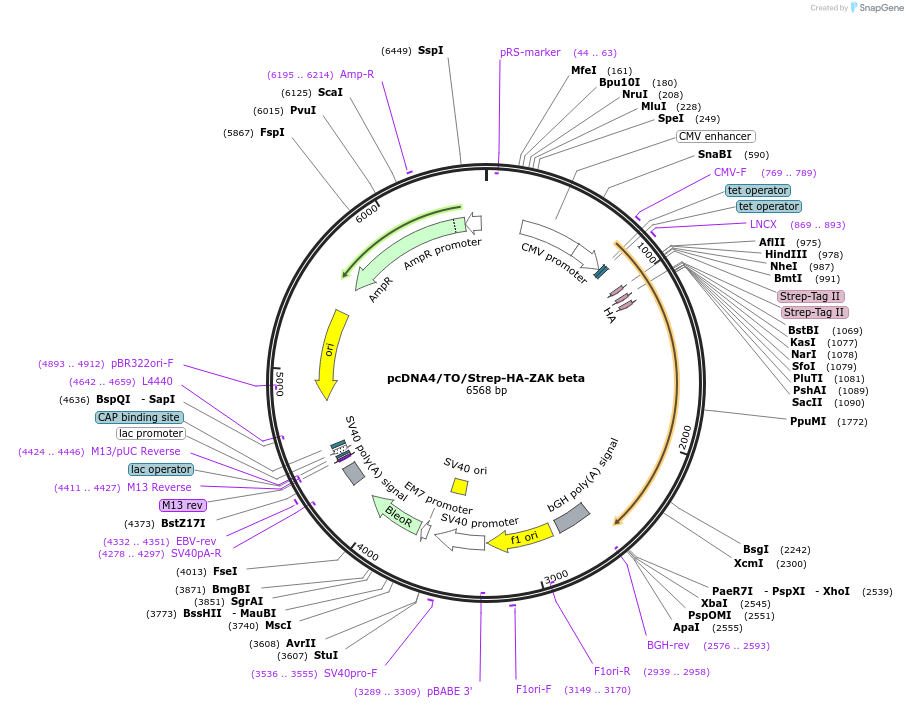pcDNA4/TO/Strep-HA-ZAK beta
(Plasmid
#141195)
-
PurposeExpresses Strep-HA-ZAK beta in mammalian cells, can be used to make inducible cell line
-
Depositing Lab
-
Sequence Information
Ordering
| Item | Catalog # | Description | Quantity | Price (USD) | |
|---|---|---|---|---|---|
| Plasmid | 141195 | Standard format: Plasmid sent in bacteria as agar stab | 1 | $89 | |
Backbone
-
Vector backbonepcDNA4/TO
-
Backbone manufacturerInvitrogen
- Backbone size w/o insert (bp) 5078
- Total vector size (bp) 6500
-
Modifications to backboneStrep and HA tags were inserted between HindIII and EcoRV sites
-
Vector typeMammalian Expression
-
Selectable markersZeocin
Growth in Bacteria
-
Bacterial Resistance(s)Ampicillin, 100 μg/mL
-
Growth Temperature37°C
-
Growth Strain(s)DH5alpha
-
Copy numberHigh Copy
Gene/Insert
-
Gene/Insert nameMAP3K20 isoform 2
-
Alt nameMitogen-activated protein kinase kinase kinase 20 isoform 2
-
Alt nameMLTK isoform 2
-
Alt nameZAK beta
-
SpeciesH. sapiens (human)
-
Insert Size (bp)2400
-
Entrez GeneMAP3K20 (a.k.a. AZK, CNM6, MLK7, MLT, MLTK, MLTKalpha, MLTKbeta, MRK, SFMMP, ZAK, mlklak, pk)
- Promoter CMV
-
Tag
/ Fusion Protein
- Strep, HA (N terminal on backbone)
Cloning Information
- Cloning method Restriction Enzyme
- 5′ cloning site NotI (unknown if destroyed)
- 3′ cloning site NotI (unknown if destroyed)
- 5′ sequencing primer CMV--F
- 3′ sequencing primer BHG-Rev
- (Common Sequencing Primers)
Terms and Licenses
-
Academic/Nonprofit Terms
-
Industry Terms
- Not Available to Industry
Trademarks:
- Zeocin® is an InvivoGen trademark.
These plasmids were created by your colleagues. Please acknowledge the Principal Investigator, cite the article in which the plasmids were described, and include Addgene in the Materials and Methods of your future publications.
-
For your Materials & Methods section:
pcDNA4/TO/Strep-HA-ZAK beta was a gift from Simon Bekker-Jensen (Addgene plasmid # 141195 ; http://n2t.net/addgene:141195 ; RRID:Addgene_141195) -
For your References section:
ZAKalpha Recognizes Stalled Ribosomes through Partially Redundant Sensor Domains. Vind AC, Snieckute G, Blasius M, Tiedje C, Krogh N, Bekker-Jensen DB, Andersen KL, Nordgaard C, Tollenaere MAX, Lund AH, Olsen JV, Nielsen H, Bekker-Jensen S. Mol Cell. 2020 Apr 9. pii: S1097-2765(20)30189-1. doi: 10.1016/j.molcel.2020.03.021. 10.1016/j.molcel.2020.03.021 PubMed 32289254



